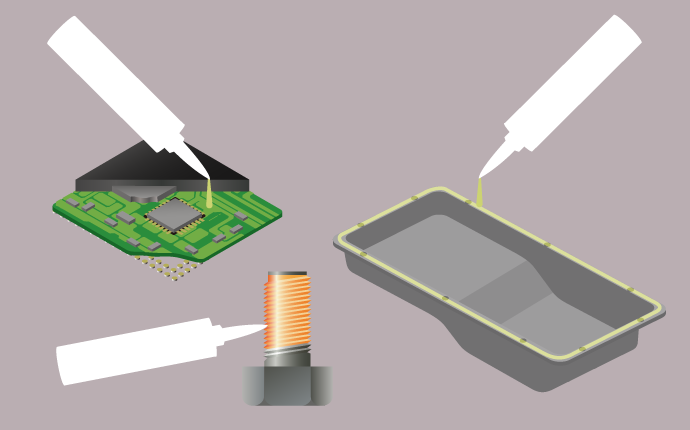If you can conquer application, you can conquer adhesives! What does it mean to use adhesives in the first place?
Adhesives are useless unless you apply them!
Have you ever used a chocolate pen for writing letters to decorate a cookie or a dessert plate? Even if you try to write neatly, the chocolate may not come out well, or you might find that the thickness is inconsistent, or that you can’t get the flow to stop where you want to stop it and it stretches, and so on. You can imagine how difficult it is to write neatly with a liquid like chocolate.

Applying adhesives can be tricky....
Just like with chocolate, it can be difficult to apply adhesives exactly the way you want. However, when you use an adhesive, there’s always a process for applying it to the object that you want to bond.
ThreeBond adhesives are used in a variety of products, like bolts, automobile oil pans, and smartphones and other electronic devices. What are the key points to consider when applying adhesives to products like these?

- The objects have different shapes.
There are various diverse methods of application, including linear application for oil pans of automobile engines, pinpoint application for electronic devices, and application to bolts, pipes, and other non-flat surfaces. You have to change the application method depending on the shape.
- Different adhesives have different physical properties.
Each ThreeBond adhesive has different properties. For example, let's look at viscosity, which we explained in a previous column (“A breakdown of familiar queries: What unit is used to measure viscosity?”). If you just look at viscosity, there are many different types: thin liquids like water, viscous liquids like honey, and pasty substances like toothpaste. When squeezing an adhesive out, you have to consider its viscosity so you can adjust the level of force.
- The amount to apply depends both on the adhesive and on the customer’s requirements.
It’s not always the case that you can increase the bonding strength of an adhesive simply by applying more. In reality, if you don’t apply the appropriate amount, you may not be able to achieve the intrinsic performance. Also, if a customer requests that you apply XX grams of adhesive to their product, you must apply that exact quantity. In any case, you must apply the specified quantity without any variation.
You need both speed and accuracy.
If you don’t ensure the points mentioned above, the adhesive will not be able to achieve its full performance, and any liquid agent or cured material (scum) that overflows could get mixed into products, or the adhesive could stick to the moving parts of the product and impede movement, resulting in a defective item.

If you have a craftsperson who painstakingly hand-makes just a few products per day, you may be able to rely on them to finish everything perfectly. However, most manufacturers have to produce hundreds to tens of thousands of products a day, which is absolutely impossible for people to do by hand.
But it’s all right; we have application equipment that can do it.
Application equipment is indispensable for ensuring both productivity and quality for our customers. It automatically controls both the amount of adhesive and the speed at which it is dispensed according to the physical properties of the adhesive and the shape of the object to which the adhesive is applied. ThreeBond also develops and sells application equipment, and offers proposals on how to apply adhesives to maximize their performance.
Click the links below to visit the pages for our diverse selection of products. Each product information page also has videos of the application process.
Feel free to contact our sales engineers if you have any questions or concerns about adhesives or application methods.
